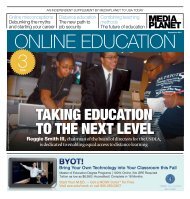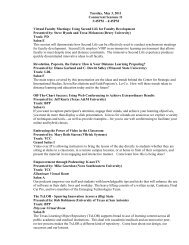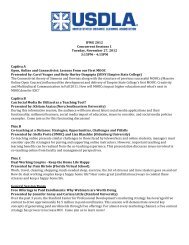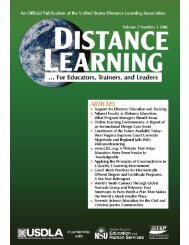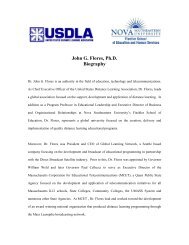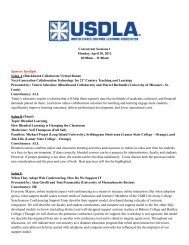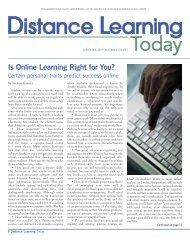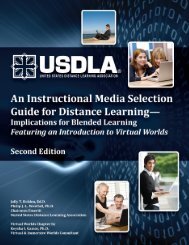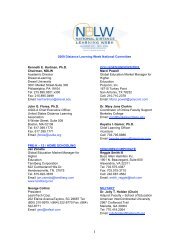United States Distance Learning Association
United States Distance Learning Association
United States Distance Learning Association
- No tags were found...
You also want an ePaper? Increase the reach of your titles
YUMPU automatically turns print PDFs into web optimized ePapers that Google loves.
Table 3.<br />
Changes in Learner and Instructor Roles<br />
Changing<br />
learners’<br />
roles<br />
Changing<br />
instructors’<br />
roles<br />
• from learners as passive receptacles for hand-me-down knowledge to learners as constructing<br />
their own knowledge;<br />
• learners become adept at complex problem-solving activities rather than just memorizing<br />
facts;<br />
• more activities in which learners refine their own questions and search for answers;<br />
• more collaborative/cooperative assignments with learners working as group members;<br />
• group interaction significantly increased;<br />
• increased multicultural awareness;<br />
• independent, self-motivated managers of their own time;<br />
• discussion of learners’ own work in the classroom;<br />
• emphasis on knowledge use rather than only observation of the teacher’s expert performance<br />
or just learning to “pass the test”;<br />
• emphasis on acquiring learning strategies (both individually and collaboratively); and<br />
• access to resources is significantly expanded<br />
• instructors’ role changing from oracle and lecturer to consultant, guide, and resource<br />
provider;<br />
• instructors become expert questioners, rather than providers of answers;<br />
• instructor provides structure to student work, encouraging self-direction;<br />
• from a solitary instructor to a member of a learning team (reduces isolation sometimes<br />
experienced by instructors);<br />
• from instructor having total autonomy to activities that can be broadly assessed;<br />
• from total control of the teaching environment to sharing with the participants as fellow<br />
learner;<br />
• more emphasis on sensitivity to student’s learning styles; and<br />
• instructor-learner hierarchy is broken down<br />
bility for his or her learning (Brown, Murphy,<br />
& Wade, 2006; Murray, 2001). To<br />
remain competitive, an instructor-centered<br />
approach to training will no longer work<br />
in today's workplace. The new emphasis<br />
helps employees to handle a variety of jobs<br />
and unpredictable problems (see Table 3)<br />
(Berge, 1996).<br />
STAGES OF ORGANIZATIONAL<br />
CAPABILITIES<br />
Organizations struggle with this type of<br />
change—and they do not have it all figured<br />
out yet, but some companies are<br />
closer than others in their understanding<br />
of when, where, and how distance training<br />
can help them become competitively<br />
advantaged. These organizations have a<br />
better understanding because they have<br />
integrated a combination of project management,<br />
program management, change<br />
management, and strategic planning to<br />
include distance education as part of the<br />
profile of their organization.<br />
When considering the distance delivery<br />
of education and training, it is useful to<br />
think of the learning “stages” the enterprise<br />
goes through that are analogous to the<br />
learning processes of maturing individuals.<br />
A brief model that describes stages of organizational<br />
maturity, or capabilities, with<br />
regard to the delivery of distance education<br />
(Schreiber & Berge, 1998) might be:<br />
• Predistance Training and Education<br />
Stage: The organization has not<br />
attempted to use distance learning.<br />
• Stage 1: Separate or sporadic distance<br />
learning events occur in the organization.<br />
• Stage 2: The organization’s technological<br />
capability and infrastructure can<br />
support distance learning events. When<br />
distance education events occur, they<br />
are replicated through an interdisciplinary<br />
team which responds to staff and<br />
4 <strong>Distance</strong> <strong>Learning</strong> Volume 4, Issue 4



